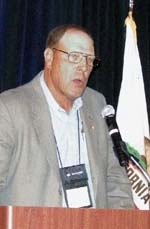NAAB Symposium
The Best-Kept Secret in the
Commercial Cow Business
On most commercial cow-calf operations, artificial insemination (AI) is not a regular practice. According to California rancher Herb Holzapfel, it’s because producers believe AI is too expensive. They’ve heard it requires specialized working facilities, and they consider AI synchronization protocols too time-consuming.

Herb Holzapfel
“The reality is that AI is very do-able for the average cowman,” Holzapfel stated. “But it must be a secret, because so few of us are using it.”
Holzapfel and his wife, Ginger, are veterans of AI. The couple started breeding yearling heifers artificially in 1973. Holzapfel admitted to drifting away from AI for awhile. Because of the lack of accurate progeny performance data for available AI sires, AI offered no advantage. Economics brought them back, as prices for “good” bulls to use naturally climbed steadily higher. Additionally, there had been a significant improvement in the amount and accuracy of information on which to base AI sire selection.
Holzapfel thinks the industry has led producers to think AI is very difficult, but in his experience, facilities don’t have to be elaborate. Nearly any basic chute setup can be used for AI, he said. He encouraged ranchers not to let the time factor be a deterrent.
“The average amount of time for a synchronization program is three to five minutes per cow,” Holzapfel said. “That’s three trips down the chute, not including the sorting and gathering.”
Holzapfel said investing time in training heifers to go through a working facility is well worthwhile. The training stays with them forever. Over time, cattle work better and easier when handled using low-stress techniques. And, he added, AI conception rates will be better.
“I have used almost every synchronization (protocol), over time, and they all seem to work,” Holzapfel said. “I can assure you, though, none of them will be as good as you think they should be when you are starting out. Don’t get discouraged.”
For heifers, Holzapfel said he considers 60% conception on the first heat cycle to be good. With cows, 70% would be very acceptable. However, when first implementing synchronized AI, producers should not be disappointed if conception rates fall a bit short of those marks. If producers commit for the long term, Holzapfel said, conception rates will improve. The very best conception rates, in his experience, result from natural heat detection, rather than synchronization.
For producers committed to using top genetics, Holzapfel believes AI saves money and makes money as well. The prize AI provides, Holzapfel added, is calves with added value. He cited greater consistency among marketed steers and heifers, and heifers retained as herd replacements.
“I honestly believe if you are going to be in the ranching business in the future, your very existence will depend on your ability to supply a better, more consistent product,” Holzapfel stated.
Regarding selection of AI sires, Holzapfel advised producers to seek out “high-conception-rate bulls." Experience, he said, has taught him that all sires are not created equal.
Holzapfel added that getting cows bred on the first heat cycle is a means to generating more profit, so using semen from high-conception-rate sires is important.
Editor’s Note: This summary was written under contract or by staff of Angus Productions Inc. (API). To request reprint rights contact Shauna Rose Hermel, editor, at 816-383-5270. PowerPoints are posted with permission of the presenter and may not be reproduced in whole or in part without the express permission of the presenter.
The 41st BIF Research Symposium and Annual Meeting was hosted by the California Beef Cattle Improvement Association and the California Cattlemen's Association. For more information, visit www.bifconference.com or www.calcattlemen.org/bif2009.html.



